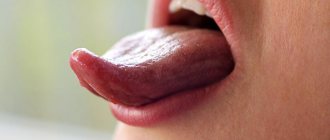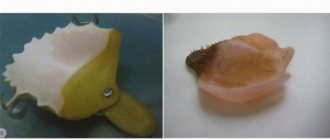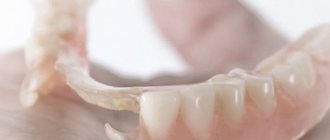Problem: a 55-year-old woman came to the Family Dentistry with a complaint about a round, protruding formation in the oral cavity, on the cheek, which did not hurt, but created discomfort. The preliminary diagnosis made by the surgeon was fibroma of the oral mucosa.
Solution: surgical removal of fibroids from the oral mucosa using a laser was performed. The diagnosis of fibroma was confirmed by histology.
Surgeon V.P. Alaverdov explained to the patient during the consultation what kind of formation was in her mouth (preliminary diagnosis - fibroma), and how to eliminate it. Since the operation does not take long and is performed under local anesthesia, cheek fibroids can be removed on the day of the consultation.
Fibroma
is a benign neoplasm of connective tissue. In appearance, oral fibroma is a raised, round formation with a wide base or stalk. Fibroma can be located on the mucous membrane of the cheeks, lips, tongue or soft palate. The surface of the fibroma is smooth, without growths or other changes in the mucosa.
The appearance of fibroids is provoked by frequent injuries to the oral mucosa, for example, with sharp edges of teeth or dentures, frequent cheek biting, as well as chronic inflammatory processes (stomatitis, gingivitis, periodontitis, etc.). Clarifying the cause of fibroma is important in order to prevent its secondary formation, eliminate the traumatic factor, or compensate for chronic diseases. In the case under consideration, the cause was injury to the cheek by the sharp cusps of the distant teeth. It is recommended to consult a dentist about smoothing out the bumps.
Fibroids usually grow slowly in size, and foreign body discomfort is the reason to see a doctor when the fibroids become large enough.
Fibroma is not dangerous in itself, but frequent trauma to the fibroma can lead to its malignant degeneration.
In this case, there are two formations that are located on the buccal mucosa. By all characteristics, these neoplasms correspond to fibroma (an exact diagnosis is established only after histology) - they have a dense consistency, rise above the surface of the mucosa, are located on a stalk, there are no changes on the surface.
The treatment for oral fibroids is surgical removal. The operation is performed under local anesthesia and does not require any preparation.
The surgeon offered to remove the fibroma with a laser on the same visit, to which the patient agreed.
What it is
Oral fibroma is a benign formation, similar to a small nodule on a stalk, which consists of connective tissue. Most often it appears on the mucous membrane of the gums, lips, cheeks or palate, less often on the tongue. Children aged six to fifteen years are more susceptible to the pathological process.
Fibroma at the initial stage of its formation is completely invisible, it does not bring any discomfort to the patient. As it grows, it thickens and swells.
Despite the fact that fibroma is not so dangerous, it must be treated. If the formation becomes larger in size and is constantly injured, a wound forms, which becomes infected. In such a situation, treatment will take longer and will be much more difficult.
In most cases, surgical excision of the fibroid is required.
Collagenous fibroma of the hard palate: description of a rare clinical case
Introduction
Collagenous fibroma is a benign soft tissue lesion first described by Evans in 1995. It develops from a cell with a fibroblast phenotype and is characterized by significant accumulation of collagen. The disease is quite rare and does not have a characteristic anatomical location. The etiology of the disease is unknown; it is assumed that it is based on either a reactive process or a true neoplastic process. One of the existing hypotheses suggests that the basis of the disease is a chromosomal rearrangement (11q 12).
Clinically, the disease manifests itself as a slowly growing painless formation. Localization can be different: the formation can be located on the arms, shoulder girdle, feet or legs, thighs and hands. However, only a few cases of localization on the head and neck are described in the literature: two on the hard palate and one in the parotid gland.
Microscopic examination reveals a well-defined soft tissue formation consisting predominantly of a collagenous extracellular matrix with rare dispersed spindle-shaped fibroblasts. It can vary in size from two millimeters to several centimeters.
As a rule, the disease is asymptomatic, with the exception of secondary traumatic ulceration of the surface. The standard of treatment is complete surgical excision of the formation. Recurs rarely.
This article describes a clinical case of collagenous fibroma of the hard palate, located from the upper second premolar on the right to the upper second molar on the right. There was no history of mucosal trauma or irritation.
Description of a clinical case
A 28-year-old woman was admitted to the periodontal department with a complaint of unaesthetic appearance of her teeth and a desire to whiten her teeth. During a general examination, no developmental anomalies or external signs of the disease were noted. Dental history, life history without any peculiarities. Denies systematic use of medications. Lymph nodes are not palpable.
Rice. 1. Photograph of the hard palate of the oral cavity before surgery.
Upon examination of the oral cavity, a single hard, non-displaceable, pedunculated formation measuring 4x2 cm was discovered, located on the right side of the palatal plate from the second right upper premolar to the second upper right molar (see Fig. 1). The affected tooth is asymptomatic, without pathology. The surface of the formation is not ulcerated, there is no pathological bleeding. The color of the formation corresponds to the adjacent mucous membrane of the hard palate. Periapical radiographic examination revealed no pathology (see Fig. 2), although occlusal radiography was not performed.
Rice. 2. X-ray of the affected area before surgery.
According to the patient's questioning, the formation appeared about one year ago. There was no history of trauma or irritation of the mucous membrane. Education reached its current size in one year. No other pathology of the oral cavity was detected during visual examination. Based on the results of the examination, a preliminary diagnosis of fibroma was made.
Fig 3. Removed tissue.
Laboratory data: hemoglobin 97 g/l, bleeding time 3 minutes, blood clotting time 5 minutes 30 seconds.
Rice. 4. Photograph of the affected area of the hard palate 1 week after surgery.
After careful treatment and sanitation of the oral cavity, complete surgical removal of the formation was performed under local anesthesia; the tissue sample was sent for histological examination. A periodontal surgical dressing was applied and recommendations were given. The postoperative period passed without complications (see Fig. 4).
Rice. 5. Microscopic examination of a sample of removed tissue.
Histopathological examination reveals cell-poor soft tissue with clear boundaries, consisting predominantly of fibrous tissue nodules (see Fig. 5). Mitotic figures, areas of necrosis, bone formation from periosteum, and calcification were not observed.
The patient was observed regularly for 2 years, once every 3 months; no recurrence of the disease was observed.
Discussion
Soft tissue cancers are relatively common, but diagnosing them often presents certain difficulties. The diagnosis of collagenous fibroma is made primarily on the basis of morphological data, since immunohistochemical studies are not informative enough.
Rice. 6. Photograph of the hard palate 2 years after surgery.
However, in the differential diagnosis, it is wise to exclude other diseases, including inflammatory fibroma, traumatic fibroma, giant cell fibroma, and neurofibroma. Only a few cases of collagenous fibroma localized on the head or neck have been described in the literature (two cases with fibroma localized on the hard palate and one case localized in the parotid gland). The etiology of the disease is unknown; it is assumed that it is based on either a reactive process or a true neoplastic process. The hypothesis of post-traumatic development of the disease is discussed in the literature. There is also a hypothesis about the development of the disease due to chromosomal rearrangement (11q 12).
Conclusion
This article describes a clinical case of the development of collagenous fibroma on the hard palate, in the absence of a history of trauma or irritation of the oral mucosa. There was no recurrence of the disease after treatment over a two-year period. The prognosis of the disease is good.
Reasons for the growth of education
Scientists have not identified the exact reasons for the growth of fibroids in the oral cavity. But there is a list of factors that provoke the appearance of an anomaly:
- hereditary factor (as a rule, fibroma appears in very young patients aged from one to ten years);
- constant injury (regular biting of one area of soft tissue, injury from the sharp edges of a filling, crown or orthodontic structure, eating very hard food);
- taking certain medications (epileptic drugs, some hormonal pills, drugs that correct vascular tone);
- inflammatory processes in the oral cavity (stomatitis, periodontal disease, glossitis).
It is impossible to exclude a genetic predisposition, but you can reduce the risk of the problem if you follow basic preventive measures:
- do not neglect oral hygiene;
- clean the oral cavity from soft and hard plaque using professional hygiene;
- treat the soft tissues of the oral cavity with care (avoid temperature changes when eating, do not abuse solid foods);
- promptly treat diseases of teeth and gums;
- do not self-medicate;
- undergo preventive examinations with a dentist once every six months.
Types of fibroids
There are two types of tumors: soft and hard.
Soft fibromas in a child are characterized by very slow growth, rather flabby consistency, mobility and clear localization. Such growths occur mainly in the genital area and anus, sometimes forming multiple clusters. Solid neoplasms are smooth or slightly rough pink and flesh-colored nodules with dense contents. Such fibromas are located on a wide base and, as a rule, do not exceed 1 cm in size.
What are fibroids?
The formations are divided into several types, differing in their density, nature of origin and how severe the clinical manifestations of the neoplasm are. Dense education. It is characterized by a thick consistency and is most often localized on the gums and palate. Consists of soft fibers of connective tissue. Typically found on the inside of the tongue and cheeks.
Formation arising from irritation. A chronic disease caused by constant trauma to one area of the mouth. The cause may be installed fillings or prostheses, as well as piercings.
Fibrous epulis. A dense pink formation that does not cause any discomfort to the patient. It has very clear boundaries and an asymmetrical shape. Localized on the vestibular region of the gums or in the interdental spaces.
Symptoms
The development of the tumor process is accompanied by moderate pain and a feeling of fullness. In 55–60% of cases, the pathology is asymptomatic. The likelihood of developing specific signs of fibromatosis depends on the type and location of the tumor. Fibromatosis of cartilaginous tissue is characterized by increasing symptoms - from mild pain when performing movements to complete loss of mobility of the upper or lower limb.
Specific symptoms develop when fibroma affects the patient’s internal organs. Thus, fibrosis of the uterus can cause bleeding that is not related to a girl’s menstrual cycle. Fibrous lesions of the lungs provoke difficulty breathing and shortness of breath in a child or adult after short physical activity.
Diagnosis and treatment
Diagnostics consists of interviewing and examining the patient; if necessary, additional studies and radiography are performed.
The most common and effective method is surgery. The formation is removed using a laser; the procedure lasts about thirty minutes.
If the disease is caused by taking medications, they should be excluded and replaced with similar drugs. After stopping the medication, the appearance of the mucous membrane can be restored without any intervention. But this does not apply to cases where the pathology is advanced.
You can also do without intervention in case of traumatic effects of a prosthesis, filling or braces. Elimination of the cause of the formation leads to the disappearance of fibroids.
Thus, fibroids in the oral cavity do not pose a danger only if proper measures are taken in a timely manner. You should not take any action on your own. If a problem is detected, you should immediately contact a specialist.











